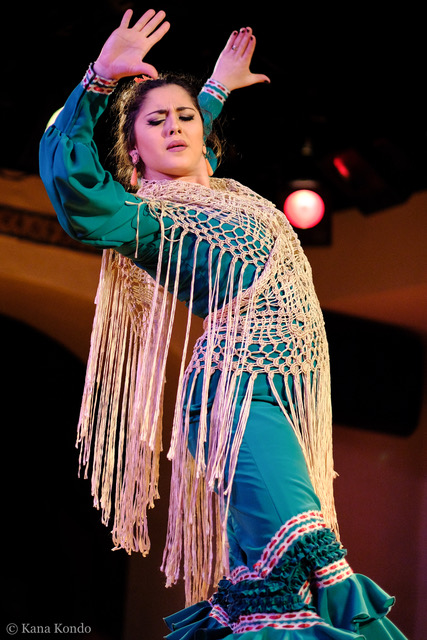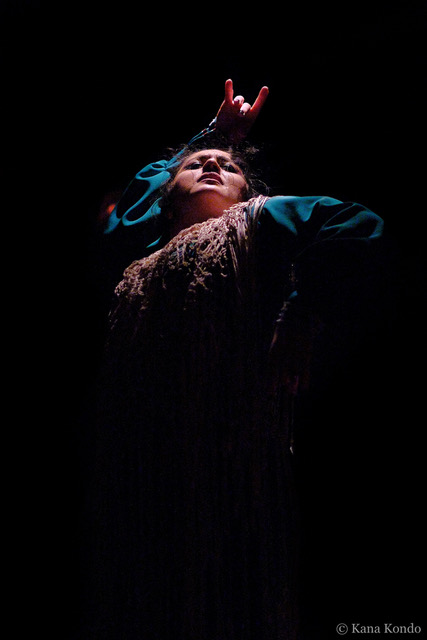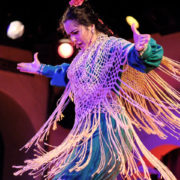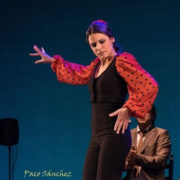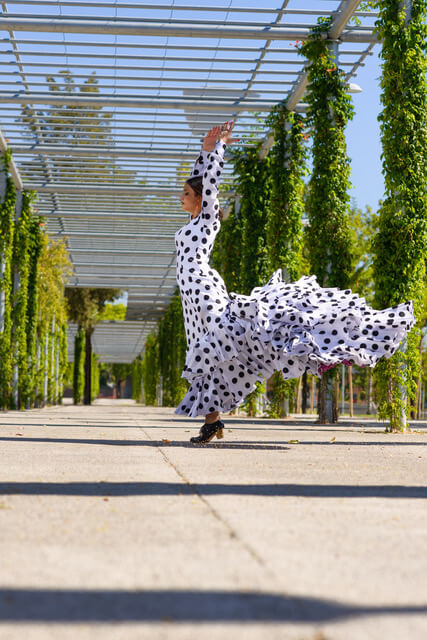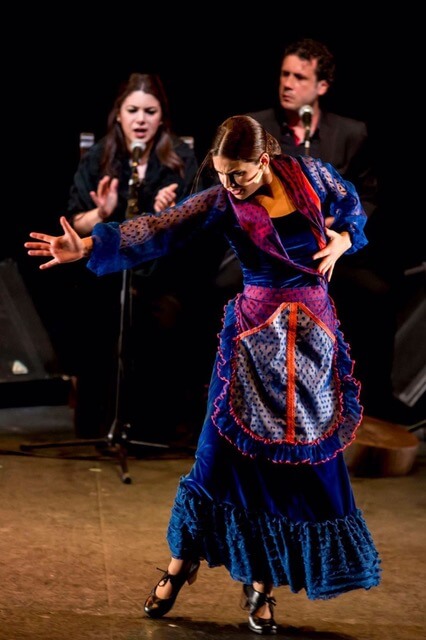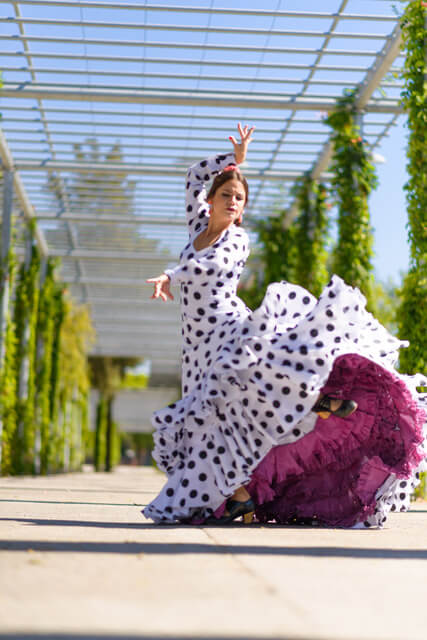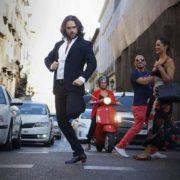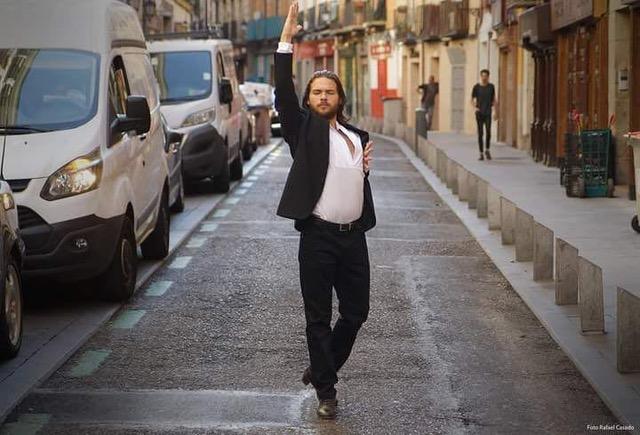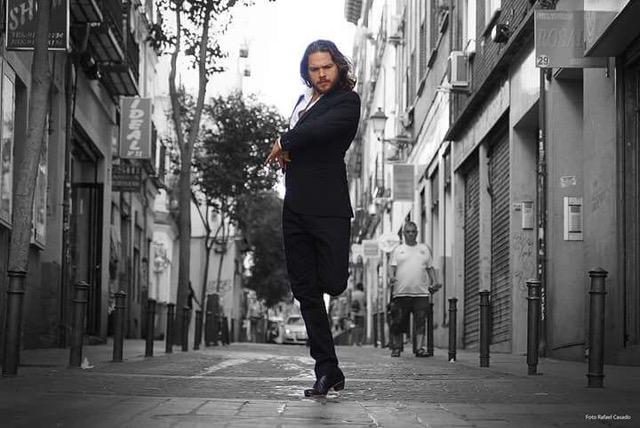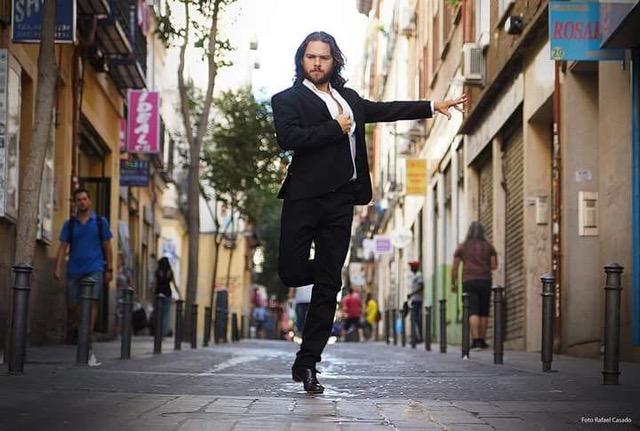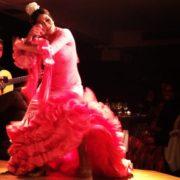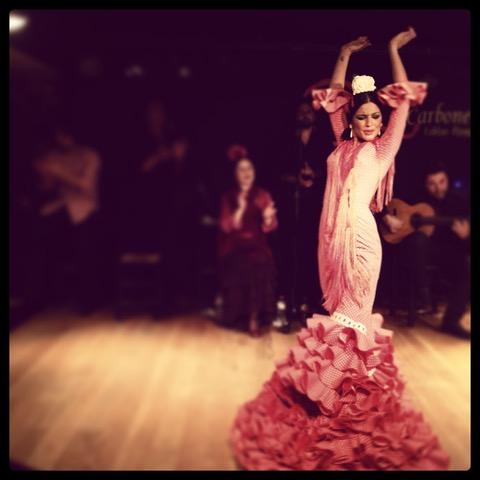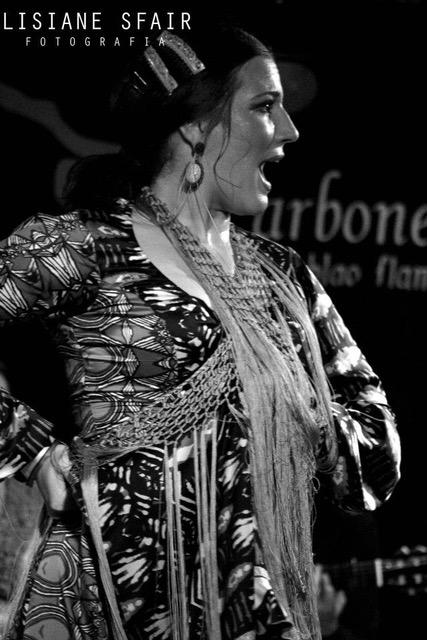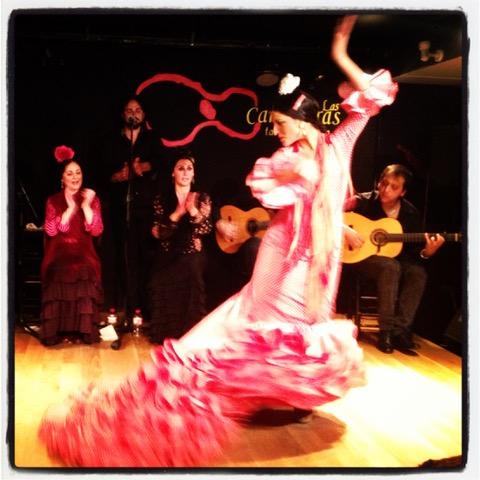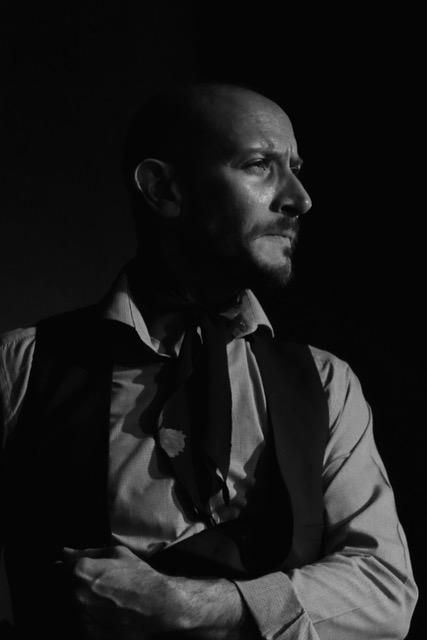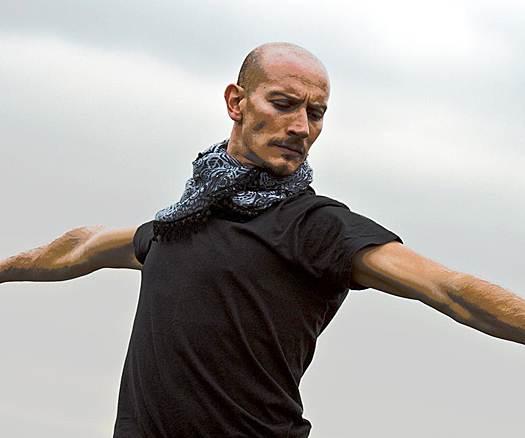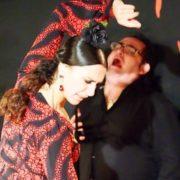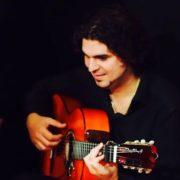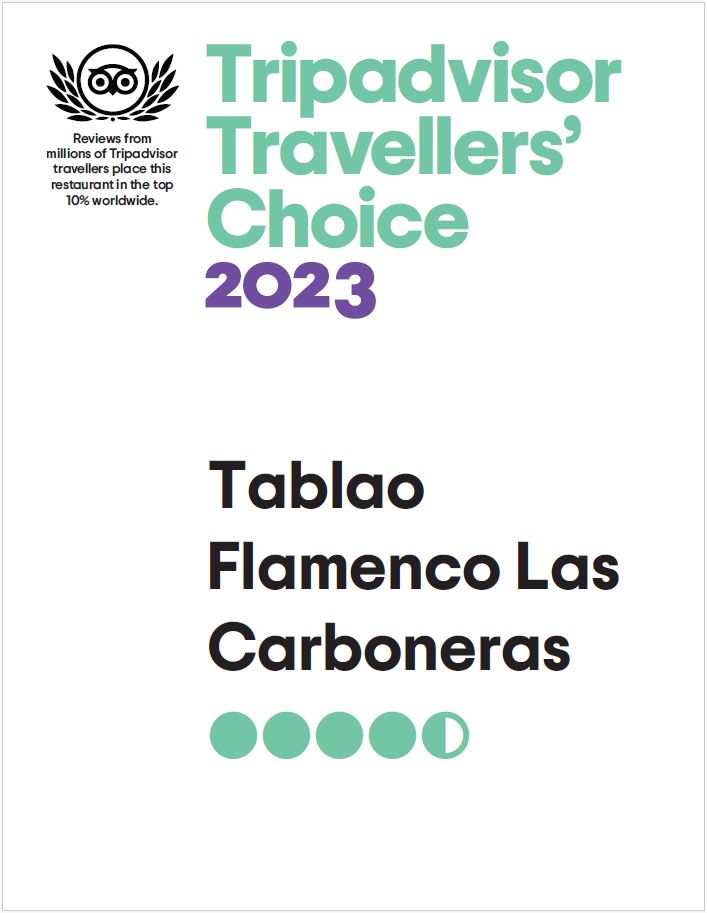Ana Romero
Born in Melbourne, Australia, with Andalusian parents, she has trained in flamenco dancing with teachers such as Manolete, “El Güito”, Belén Maya, Manolo Marín, “La China”, Manuel Reyes, Ciro, Paco Fernández, “La Tona”, Milagros Mengíbar, Paco Romero, Rafaela Carrasco, “La Tati”, Manuel Liñán, Marco Flores, Alejandro Granados, Yolanda Heredia, Alfonso Losa or David Paniagua.
Her professional experience includes a great dedication to dance in tablaos such as El Flamenco (Japan), Corral de la Morería, Venta del Gato, Café de Chinitas, Las Carboneras (Madrid) or El Carmen (Barcelona). She is one of the greatest specialists in tablao flamenco dance and stands out for her strength and refined technique.
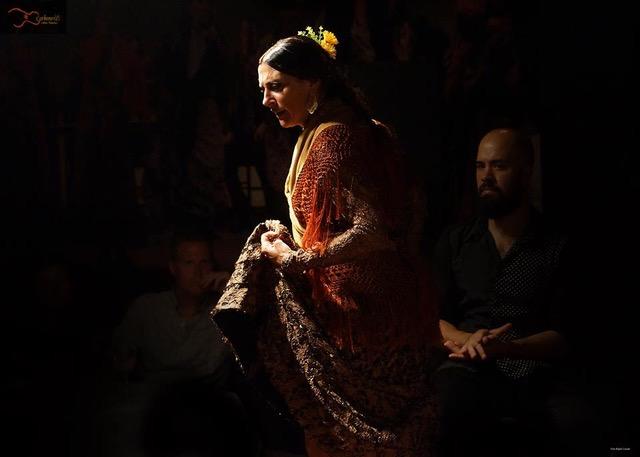
She has worked in companies such as Manuela Vargas, with which she played Fedra in Spain, Europe and South America; Luisillo, with whom she toured Europe, Asia and South America; Manolete, with which she participated in the International Festival of Music and Dance of Granada, in the Dutch Flamenco Festival, the Caracalla Festival and the Opera House in Rome; “El Güito”, with whom she danced at the Sinaloa Festival (Mexico), the Valencia Festival or the Granada Festival; Paco Peña, with whom she attended the Tall Ships Festival in Liverpool (England) and toured Australia; Andrés Cubos, with whom she performed at Paseíllo Flamenco-Katak in Madrid and Venice; Cristina Hoyos, whose company was part of the show “Arsa y toma” for three years; Antonio Vargas, whose flamenco company integrated and with whom she participated in his adaptation of the theater play “La casa de Bernarda Alba”; Belén Maya, with whom she performed at the Paris Festival, the Grenoble Festival and the Sala Caracol (Madrid); Alfonso Losa, of whose company she was part acting for the Community of Madrid; Joaquin Grilo, in whose company she took part with performances in the Festival of Jerez or the one in Logroño; in Noche Flamenca, a formation of which she was part for four years acting in the United States, Canada and Central America; La Shica, singer who accompanied for three years as a dancer, showgirl and clapper; Arrieritos: in the Sala Pradillo (Madrid) she premiered the flamenco-contemporary production “En tablao”, which also represented in the Festival of Huesca, the Puertollano Festival and the Community of Madrid; he also acted in its award-winning show “13 rosas”, with which the company won two Max awards for the best show and the best choreography in 2007; Company of Manuel Liñán, Olga Pericet, Marco Flores and Daniel Doña: she performed at the New York Flamenco Festival, at the Sydney Opera House, on a tour of Australia and Asia, at the Susan Dalai Festival in Tel Aviv, at the Festival of Jerez or at the Teatro de Madrid; Company of Manuel Liñán: she acted in the show “Mundo y aparte”.
She has also participated in other groups with performances in Madrid, Seville, the Alburquerque Festival, in New York, Washington, etc. With the Company of Marco Flores currently intervenes in “Tránsito” and “De flamencas” with a tour of Europe and the United States.
Since 2000 she is a founding member and dancer of Las Carboneras, one of the most respected flamenco tablaos in Madrid. In addition, she has participated in the films “El día que nací yo” and “Ole!”.
As a flamenco teacher she has taught courses in Brazil (Sao Paulo); Canada (Montreal, Toronto); United States (New York, San Francisco); Australia (Melbourne, Sidney, Adelaide); Spain (Madrid, Ciudad Real); Israel (Jerusalem, Tel Aviv) or Italy (Rome, Milan, Naples).
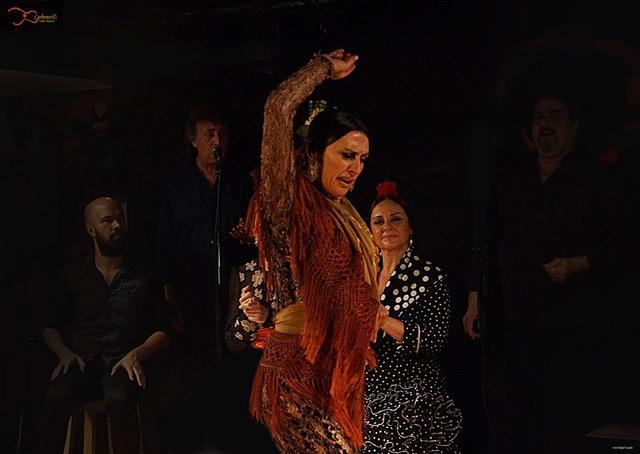
Ana Romero: “I see young people with increasingly more preparation”
The dancer Ana Romero, born in Australia of Andalusian parents, climbed to a stage for the first time when she was five years old and professionally, at fourteen. Then she came to Spain and, between tours with Manuela Vargas and Cristina Hoyos, among others, she grew as a bailaora in Madrid tablaos to become the race artist she is now. She is one of the three founding dancers of Las Carboneras and she passionately sees the progress of the new generations.
—Explain to us how it has been your experience in flamenco and how you ended up in the world of flamenco tablaos.
—I started dancing at age five in Australia in a Spanish community. My first experience was at fourteen in flamenco tablaos in Melbourne, where there were several tablaos that worked at the time. My teacher introduced me and I started dancing from Thursday to Sunday. Then I came to live in Madrid, at first I was very afraid, I had much respect, with flamenco and I didn’t dare. I spent a year and by chance my first introduction to it was through Tacha and Belén Fernández. In an amazing way because we did not know each other, but Tacha and Belén had seen me in a dance class, they liked my dancing and both were super generous and they said to me why not to go to a tablao and do a test to start working. I actually started because Belén organized it, Tacha was leaving, I took the test and went. Following that I worked in almost every tablao in Madrid. It was part of my training and my work for many years, apart from being integrated in companies. Eventually we decided to open Tablao Las Carboneras in Madrid. Sure, Tacha is my best friend and she has been my companion in the tablao throughout the time.
—Then, at the end, to call it that way, you have become a specialist in flamenco tablao.
—I would not say a specialist. I’m a worker. Besides flamenco tablao format is not easy because it is daily and not everyone likes every day. Well, Ángel Gabarre is an icon and the man works every day with the same intensity and the same desire and is very fond of it. I understand that the diary is really difficult. I identify with it, I need it and it’s my way of working, maybe because I grew up that way and we are creatures of habit. I love to work each day.
—And what is the fundamental difference between dancing every day in a tablao and another thing that you have done (also pretty much) that is acting in shows?
—Dancing in shows is very different to dance in a tablao. In a tablao there is a very direct connection with the public, it becomes more intimate. Personally, that’s what attracts me. Suddenly you find a room full of people and you are surprised of the care and connection that you have with people. In a tablao you work more the moment, what is happening to each one. Many times it does not work, but many many other it does, and that is rewarding. When you really get to that magic, it can only happen at that time and is unique because the next time it will be otherwise. And in the theater it works well but it is different, it goes with organized labor, you give vent to it more spontaneously, but in a more limited way.
—Would you like to highlight some artists who have particularly influenced you over the years you’ve been in flamenco?
—I think that everyone influences your career and passes through your life for some reason, I think things are not for free, but people who have come to me in a very special way … I was fortunate to work with Manuela Vargas, she had a very special way of working. I’m talking about many years ago and we used to work differently. It was a very special way, the emotion was very important in the work. The technique also, but the emotion was so prevalent in her work. She has influenced me and surely many people have too, though I do not remember many of them, but there is a droplet from each one that sticks to you. I have so much admiration for Ángel Gabarre in particular because I’ve been working with him since we started in Las Carboneras [2000] and the 9 years prior at the Alcazaba. Ángel is someone who comes to me in a very direct way, in a very deep form of expression and because how generous he is. I also enjoyed a lot working with Cristina Hoyos. I learned other flamenco with her. No you could tell a particular person, everyone has contributed with something. Everyone gives you gifts.
—The experience in the tablao has led you in recent years to create a dance contest that has given you the opportunity to know how are the new generations like. Where do you think flamenco is going now?
—In flamenco I see people with a great desire and really fondo f it with few opportunities to expose. In flamenco tablao, when we have done the contest, I’ve moved a lot. People show up with great enthusiasm and what they lack is experience. Unfortunately there aren’t many possibilities. About 10 years ago there were many companies where you had chances to grow in a format of companies, groups and gigs. All of that is very small now. Now I see people with great enthusiasm, desire and a lot more preparation, everytime more. They also have internet access, everything is exposed. Then it’s up to everyone to find their personality, that is done with the experience. There are few who are touched with the rod, very special people, but others, the hard workers of flamenco, that are everyone, is a long term career, go to work, creating a personality based on your experiences, what you’re like and what you feel.
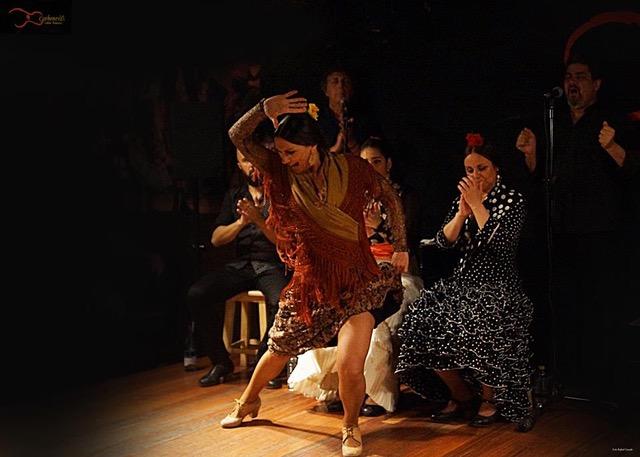
—Another thing that has characterized you is having worked extensively abroad. Do you think that flamenco is valued outside?
—I think flamenco is super valued abroad, sometimes more than right here. There is a relish and a huge respect among people committed outside Spain’s flamenco. The limits are endless, we must be grateful, there are people who come, spend their time, their hopes, their money here in Spain to continue moving it out. In flamenco, you move or do not move, but leaves no one indifferent. A wonderful flamenco is being made outside Spain, there are super important festivals that are leaving a significant height for the genre.
—And the public increases, much of the public of the tablao is from abroad.
—Yes, most of the audience is from abroad, but that means nothing. When you do your job you do it for yourself and to share it with your peers, and that does not mean sacrificing quality. The quality have to be exposed to everyone. I do not think foreigners are dummy. Just as when you go to a museum and maybe you do not understand what you are seeing, beauty is able to be grasped, the sensitivity is always there. There are all types of people, but usually I see a devoted audience, eager to see and feel.
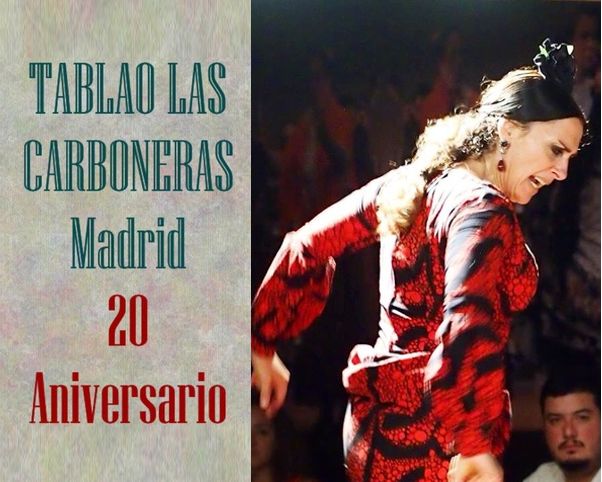
ANA ROMERO INTERVIEW
Ana Romero, dancer and co-founder of Las Carboneras
«I am very proud of my home»
«In Australia I had several teachers but one of them had spent a lot of time in Spain in a company, his name was Mario Orbitani. He really was a huge influence on me because he showed me how companies worked here. We were four companions: guitarists, singers, etc, and we did the work format of that time in Spain: you danced jotas, classical-Spanish, there was a work performed at the beginning with the dance. And the strong part was flamenco. Mario taught me a lot about the world of flamenco, also about the discipline and breadth of that era, when you had to know a little about everything. He got me the tablao bug because I started with him and other teachers in the tablaos of Melbourne when I was 14 years old. There I found my environment, the place with which I identified and felt absolutely free. It marked me so much and I believe that I also marked him that when I came to Spain, he told me: “If you leave, I’ll go back to Italy.” He took his suitcase and now lives in Pisa with his partner. A time was over and we both left, he to there and I to here. He really was a person who marked me a lot.
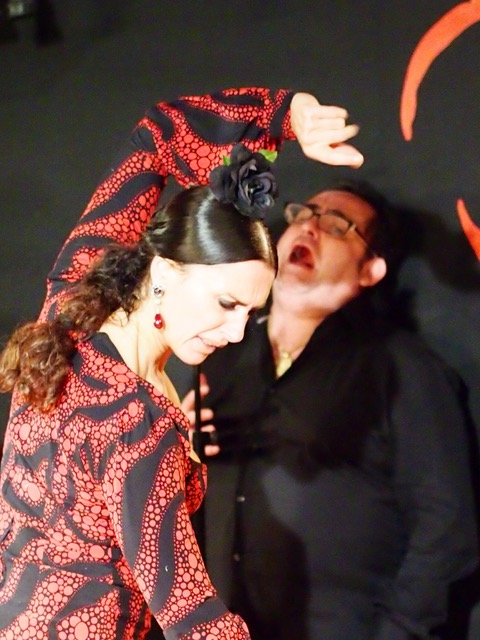
OLYMPUS DIGITAL CAMERA
»In the world of dance, I like to think that, because of my personality type, I love the tablao and I feel very lucky to be able to soak up everyone and all kinds of dance that goes through the tablao. For me that is the greatest school. And empathize with those people through dance and have, not eyes, magnifying glasses. You are drinking from different sources every day. And not only about dancing, but also singing and guitar. That was very important, as well as the work I did with Manuela Vargas in “Fedra”. Manuela also marked me a lot on a professional level, but also on a personal way: she was a very tender person with me. Maybe I was very young at that time and how you receive it is important, right? But the work was magical and the artistic direction and music by Enrique Morente, so I was blown away. We did a very modern version of Phaedra, all dressed in leather, Carlos Hipólito would go out with a motorcycle on stage, it was something very different for the time.
»It was also important to work at the Alcazaba tablao, where I met Tacha and Manuela Vega, the other dancers cofounders of our tablao. That was where Tacha and I became like the marriage that we have and we discovered each other and that something that you have very much in common with a person emerged, not only in flamenco, but also in the world of tablao.
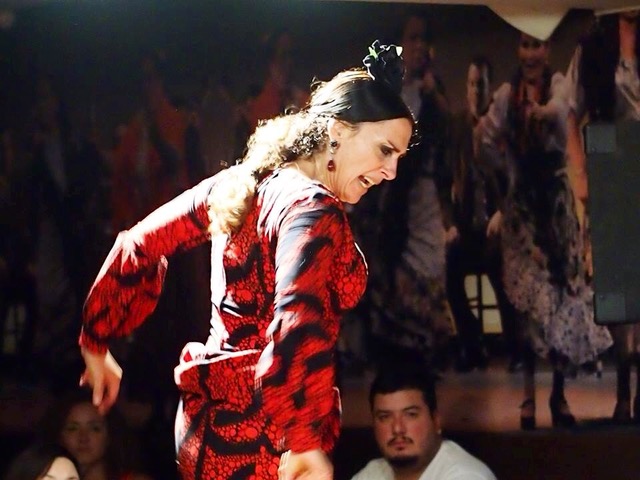
«Anecdotes in these years there have been many. One day in the tablao a cantaor was singing and a cousin of his was watching around and, suddenly, we see that the cousin goes up on stage while we are performing and whispers something in the singer’s ear, the cantaor gets off the stage and runs away. Later we found out that the car was towed away and the other, all of a sudden, got on stage to tell him. And he left, instead of giving him the keys. There was also once a very magical night in which all the power in the neighborhood went out and to be able to do the performance we put candles around the stage. Of course, we had to dance in another way, to avoid the flight of the dresses so that they did not burn. It was like very beautiful and magical, something very different. I think the public got it a lot. Then, in a particular way, I always remember a man who seemed like a country man and was in the front row. I was watching the show and I remember seeing him bruised, crying. He could not stop. He saw one and the other dance, each of us who made the cuadro and he was so so touched that he would not stop crying. He was dressed like a country man, he was a humble man. That got to me a lot. There have been many anecdotes, very nice things that you receive from the public. Suddenly, someone leaves you an anonymous note or a child gives you a drawing of what they see in your dancing. That kind of thing is also very cool to me and I have many memories of that type and the truth is that I keep them like a treasure.
»What has Las Carboneras meant? Well, my goodness, Las Carboneras! I get emotional. It has been a dream come true, something unimaginable for me, I could never have imagined that I would have a place so special, so beautiful, I at least feel it that way. Las Carboneras, for me, is a familiar place. It brings me a lot of pride because everyone feels it that way, as a place, for them, from their family. Where art is collected, but also from the heart. From everyone, from the artistic side, which we carry, to the relationships established with Kike, with the other waiters who have been and have been passing by, with the cooks … Maybe it’s also our way of working, But all those things seem just as important to me. And then, on a professional level, it had been more than thirty years since a tablao had been opened in Madrid. The opening of Las Carboneras was something very marked and of great respect for us. From the beginning we worked a lot, on a personal level. All partners we painted the room, we started from scratch. We had to participate by taking the tablecloths and bringing them washed and ironed the next day. A family job, as I say. I feel Las Carboneras with great pride, it is something built in twenty years. A lot of work and, on a professional level, I think we created a form of dance and a form of freedom, too. It’s funny but I think that many people, when they come to Las Carboneras, feel that freedom and feel unconditional support. And it is also something very of our label. That we, I’m talking about the regular, Ángel Gabarre, Tacha and I, whoever it is coming, we are always going to support him or her200 percent. And I think that’s something that people get. We are better or worse, but we do it from the heart. That is part of us. And I think we have created an exclusive and unique space that has its stamp, its brand. Not only people from here consume flamenco, but we have people from France, Mexico, from many places, who always come to see Las Carboneras, to get to know it and who are regular. I, to tell you the truth, feel a lot of pride in my house. A lot of pride for all the partners, for everything we have worked for, for all the workers. And, for many more years. Now, in these difficult times, we will have to fight again for a new beginning. I am ready, I am ready for that and for everything.
